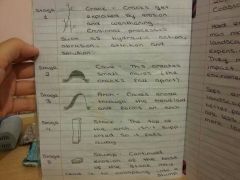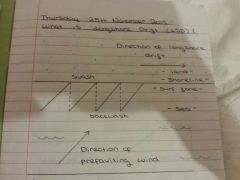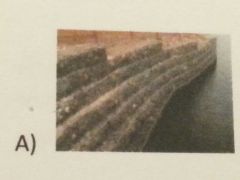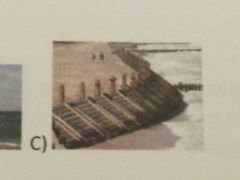![]()
![]()
![]()
Use LEFT and RIGHT arrow keys to navigate between flashcards;
Use UP and DOWN arrow keys to flip the card;
H to show hint;
A reads text to speech;
22 Cards in this Set
- Front
- Back
|
What is erosion? |
When a rock or particle in worn down by a process involving movement. |
|
|
What is weathering? |
When a rock is decomposed or loosened but does not move. |
|
|
What is abrasion (an example of erision)? |
When sand and pebbles are thrown against the cliff by the sea which wears away the cliff. |
|
|
What is attrition (an example of erision)? |
Boulders and rocks at the base of the cliff rolling around by the sea until they wear away and eventually become sand. |
|
|
What is solution (a type of erosion)? |
Salt in the sea water reacts with certain rock types such a limestone and chalk and will erode these cliffs away at a faster rate. |
|
|
What is hydraulic action (a type of erosion)? |
As water hits the cliff, air is trapped in any cracks in the cliff. When the wave goes back, this air is revealed with pressure which wears away the cliff. |
|
|
What 3 things affect the size and energy of waves? |
1) How long the wind has been blowing. 2) The strength of the wind. 3) How far the wave has traveled. |
|
|
What are the swash and backwash? |
Swash is when a wave is washed up the beach, backwash is when it runs back down. |
|
|
What is a fact about constructive (calm) waves? |
The swash is stronger than the backwash. |
|
|
What is a fact about destructive waves. |
The backwash is stronger than the swash. |
|
|
What is fetch? |
The distance that the wind blows over the surface of the sea. |
|
|
Name the stages of erosion. |

|
|
|
What is hard engineering? |
Man made, expensive, short term, high impact on environment and landscape. |
|
|
What is soft engineering? |
Better for environment, less expensive, long term. |
|
|
Diagram of long shore drift. |

|
|
|
What are gabions? |

Gabions absorb the waves energy. The last 20 to 25 years and are made up by local materials. They are also one of the cheaper options. However there may be environmental concerns and the metal rust. |
|
|
What are sea walls? |
Sea walls reflect the ways energy and protects the cliff behind. They last a long time and are most effective and let's tourists have something to walk on. It's very expensive however and is also not very environmentally helpful. |
|
|
What is rock armor? |
Rock armour absorbs waves energy. It's very effective and is good for animals and it disperses energy. However the rock is imported and it's expensive. |
|
|
What are revetments. |

Revetments stop the waves reaching the land behind. It is cheaper but it looks ugly and doesn't last as long |
|
|
3 types of weathering. |
Physical, chemical, biological. |
|
|
3 types of waves. |
Constructive, destructive, fetch. |
|
|
What are groynes? |
They are walls that prevent erosion. |

